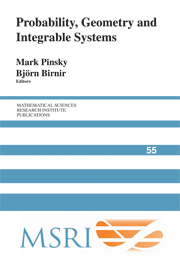Book contents
- Frontmatter
- Contents
- Preface
- Henry McKean: A tribute by the editors
- Bitangential direct and inverse problems for systems of differential equations
- Turbulence of a unidirectional flow
- Riemann–Hilbert problem in the inverse scattering for the Camassa–Holm equation on the line
- The Riccati map in random Schrödinger and random matrix theory
- SLE6and CLE6 from critical percolation
- Global optimization, the Gaussian ensemble, and universal ensemble equivalence
- Stochastic evolution of inviscid Burgers fluid
- A quick derivation of the loop equations for random matrices
- Singular solutions for geodesic flows of Vlasov moments
- Reality problems in the soliton theory
- Random walks and orthogonal polynomials: some challenges
- Integration of pair flows of the Camassa–Holm hierarchy
- Landen Survey
- Lines on abelian varieties
- Integrable models of waves in shallow water
- Nonintersecting Brownian motions, integrable systems and orthogonal polynomials
- Homogenization of random Hamilton–Jacobi–Bellman Equations
Global optimization, the Gaussian ensemble, and universal ensemble equivalence
Published online by Cambridge University Press: 27 June 2025
- Frontmatter
- Contents
- Preface
- Henry McKean: A tribute by the editors
- Bitangential direct and inverse problems for systems of differential equations
- Turbulence of a unidirectional flow
- Riemann–Hilbert problem in the inverse scattering for the Camassa–Holm equation on the line
- The Riccati map in random Schrödinger and random matrix theory
- SLE6and CLE6 from critical percolation
- Global optimization, the Gaussian ensemble, and universal ensemble equivalence
- Stochastic evolution of inviscid Burgers fluid
- A quick derivation of the loop equations for random matrices
- Singular solutions for geodesic flows of Vlasov moments
- Reality problems in the soliton theory
- Random walks and orthogonal polynomials: some challenges
- Integration of pair flows of the Camassa–Holm hierarchy
- Landen Survey
- Lines on abelian varieties
- Integrable models of waves in shallow water
- Nonintersecting Brownian motions, integrable systems and orthogonal polynomials
- Homogenization of random Hamilton–Jacobi–Bellman Equations
Summary
ABSTRACT. Given a constrained minimization problem, under what conditions does there exist a related, unconstrained problem having the same minimum points? This basic question in global optimization motivates this paper, which answers it from the viewpoint of statistical mechanics. In this context, it reduces to the fundamental question of the equivalence and nonequivalence of ensembles, which is analyzed using the theory of large deviations and the theory of convex functions.
In a 2000 paper appearing in the Journal of Statistical Physics,we gave necessary and sufficient conditions for ensemble equivalence and nonequivalence in terms of support and concavity properties of the microcanonical entropy. In later research we significantly extended those results by introducing a class of Gaussian ensembles, which are obtained from the canonical ensemble by adding an exponential factor involving a quadratic function of the Hamiltonian. The present paper is an overview of our work on this topic. Our most important discovery is that even when the microcanonical and canonical ensembles are not equivalent, one can often find a Gaussian ensemble that satisfies a strong form of equivalence with the microcanonical ensemble known as universal equivalence. When translated back into optimization theory, this implies that an unconstrained minimization problem involving a Lagrange multiplier and a quadratic penalty function has the same minimum points as the original constrained problem.
The results on ensemble equivalence discussed in this paper are illustrated in the context of the Curie–Weiss–Potts lattice-spin model.
1. Introduction
Oscar Lanford, at the beginning of his groundbreaking paper [Lanford 1973], describes the underlying program of statistical mechanics.
Information
- Type
- Chapter
- Information
- Probability, Geometry and Integrable Systems , pp. 131 - 166Publisher: Cambridge University PressPrint publication year: 2008
